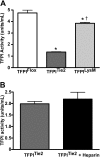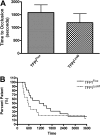Endothelial-derived tissue factor pathway inhibitor regulates arterial thrombosis but is not required for development or hemostasis
- PMID: 20516367
- PMCID: PMC2947398
- DOI: 10.1182/blood-2009-10-250910
Endothelial-derived tissue factor pathway inhibitor regulates arterial thrombosis but is not required for development or hemostasis
Abstract
The antithrombotic surface of endothelium is regulated in a coordinated manner. Tissue factor pathway inhibitor (TFPI) localized at the endothelial cell surface regulates the production of FXa by inhibiting the TF/VIIa complex. Systemic homozygotic deletion of the first Kunitz (K1) domain of TFPI results in intrauterine lethality in mice. Here we define the cellular sources of TFPI and their role in development, hemostasis, and thrombosis using TFPI conditional knockout mice. We used a Cre-lox strategy and generated mice with a floxed exon 4 (TFPI(Flox)) which encodes for the TFPI-K1 domain. Mice bred into Tie2-Cre and LysM-Cre lines to delete TFPI-K1 in endothelial (TFPI(Tie2)) and myelomonocytic (TFPI(LysM)) cells resulted in viable and fertile offspring. Plasma TFPI activity was reduced in the TFPI(Tie2) (71% ± 0.9%, P < .001) and TFPI(LysM) (19% ± 0.6%, P < .001) compared with TFPI(Flox) littermate controls. Tail and cuticle bleeding were unaffected. However, TFPI(Tie2) mice but not TFPI(LysM) mice had increased ferric chloride-induced arterial thrombosis. Taken together, the data reveal distinct roles for endothelial- and myelomonocytic-derived TFPI.
Figures





Comment in
-
Balancing clotting.Blood. 2010 Sep 9;116(10):1634-5. doi: 10.1182/blood-2010-06-289918. Blood. 2010. PMID: 20829379 No abstract available.
Similar articles
-
Endogenous tissue factor pathway inhibitor in vascular smooth muscle cells inhibits arterial thrombosis.Front Med. 2017 Sep;11(3):403-409. doi: 10.1007/s11684-017-0522-y. Epub 2017 May 27. Front Med. 2017. PMID: 28550640
-
The effect of vascular smooth muscle cell-targeted expression of tissue factor pathway inhibitor in a murine model of arterial thrombosis.Thromb Haemost. 2004 Sep;92(3):495-502. doi: 10.1160/TH04-01-0006. Thromb Haemost. 2004. PMID: 15351845
-
Tissue factor pathway inhibitor gene disruption produces intrauterine lethality in mice.Blood. 1997 Aug 1;90(3):944-51. Blood. 1997. PMID: 9242522
-
Structure and biology of tissue factor pathway inhibitor.Thromb Haemost. 2001 Oct;86(4):959-72. Thromb Haemost. 2001. PMID: 11686353 Review.
-
Tissue factor pathway inhibitor gene disruption.Blood Coagul Fibrinolysis. 1998 Mar;9 Suppl 1:S89-92. Blood Coagul Fibrinolysis. 1998. PMID: 9819035 Review.
Cited by
-
Vascular Manifestations of COVID-19 - Thromboembolism and Microvascular Dysfunction.Front Cardiovasc Med. 2020 Oct 26;7:598400. doi: 10.3389/fcvm.2020.598400. eCollection 2020. Front Cardiovasc Med. 2020. PMID: 33195487 Free PMC article. Review.
-
Neutrophils release brakes of coagulation.Nat Med. 2010 Aug;16(8):851-2. doi: 10.1038/nm0810-851. Nat Med. 2010. PMID: 20689544 No abstract available.
-
Thromboinflammation in Myeloproliferative Neoplasms (MPN)-A Puzzle Still to Be Solved.Int J Mol Sci. 2022 Mar 16;23(6):3206. doi: 10.3390/ijms23063206. Int J Mol Sci. 2022. PMID: 35328626 Free PMC article. Review.
-
The contribution of TFPIα to the hemostatic response to injury in mice.J Thromb Haemost. 2021 Sep;19(9):2182-2192. doi: 10.1111/jth.15430. Epub 2021 Jul 14. J Thromb Haemost. 2021. PMID: 34160126 Free PMC article.
-
A balance between TFPI and thrombin-mediated platelet activation is required for murine embryonic development.Blood. 2015 Jun 25;125(26):4078-84. doi: 10.1182/blood-2015-03-633958. Epub 2015 May 7. Blood. 2015. PMID: 25954015 Free PMC article.
References
-
- Rosenberg RD, Aird WC. Vascular-bed–specific hemostasis and hypercoagulable states. N Engl J Med. 1999;340(20):1555–1564. - PubMed
-
- Novotny WF, Girard TJ, Miletich JP, Broze GJ., Jr Purification and characterization of the lipoprotein-associated coagulation inhibitor from human plasma. J Biol Chem. 1989;264(31):18832–18837. - PubMed
-
- Novotny WF, Palmier M, Wun TC, Broze GJ, Jr, Miletich JP. Purification and properties of heparin-releasable lipoprotein-associated coagulation inhibitor. Blood. 1991;78(2):394–400. - PubMed
Publication types
MeSH terms
Substances
Grants and funding
LinkOut - more resources
Full Text Sources
Medical
Molecular Biology Databases
Research Materials
Miscellaneous

